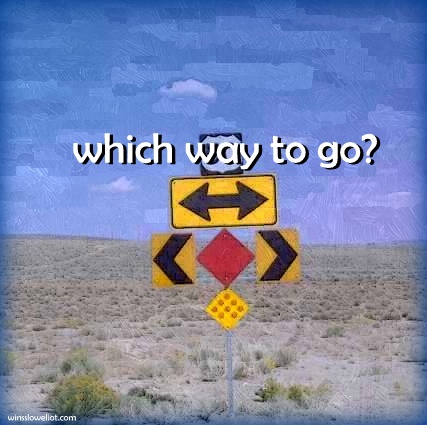
Stillness 6-25: When you come to a big decision you have to make, it’s rare that you’re trying to figure out the road to take. Because, actually, either way will look the same. The landscape is the same, your body, your vehicle, your mind is the same. The road is the same asphalt substance whichever way you turn. What you’re really curious about is your destination. Where do you want to go? Where do you want to be? In five years, what do you want to be doing and who do you want in your daily life? You’re not asking which road to take, but what destination to aim for.
For example, someone might ask me whether or not they should get a divorce. When I take them into a look ahead at what a final separation would feel like in five years, a quiet clarity settles around what otherwise feels like the terrible horns of a dilemma. Sometimes they’ll feel a ghastly sense of “uh-oh wrong way” and opt for making the marriage work. Other times this future progression exercise lifts them into a sense of freedom they haven’t felt since they tied the knot. They decide to move forward with the paperwork.
I’m not talking about a five-year-plan. A five-year-plan is useful as a road map to show how to get from hither to thither in your life’s path, whether that’s career, family, creative endeavors, adventure, or living situation. It can be very helpful to outline the steps you need to take and steer the course so you accomplish what you set out to do. But it’s a map, not a brochure of where you’re going.
Future progression is more like opening a brochure into your potentials and possibilities. It’s a different kind of exercise. In your mind’s eye, you’re taken into your future self and you get a sense of how you feel about a situation or person. We cover various scenarios: this is you at forty if you choose this path. Or sixty-five. Or ninety. And this is how you feel if you choose the other way. The process is never discouraging and worrying, because it’s so empowering and freeing. Your future doesn’t exist as a reality until it happens, and then it’s the present. Until that moment of realizing the future, it exists as potential. Only once consciousness and action meet do they manifest. You really are free to create the future you want to have—the challenge is usually that we don’t know what we want! A future progression exercise clarifies that.
Today, I have a big decision to make, so I’m going to practice this for myself. It’s much easier to have a practitioner take you through the steps and get you into a higher state of awareness, but, yes, you can do it for yourself too. Go into a deep meditation and then travel gently through the years forward. Glide through them with a steady awareness of what is happening—without any worries or judgment or inner self-critic. Let all your thoughts drift past like trees by the side of the road.
When you arrive at the age or time or place that you’re wondering about, be still. What do you feel? Who do you see? Don’t use your mind to answer those questions: center yourself in your expanded heart, in your higher knowing. Sometimes the answer doesn’t come through words but through feeling.
Afterward, travel back gently the way you came. Then get a pen and paper and use your non-dominant hand to write about the experience. It doesn’t matter if you can read it, you still might be surprised at the feelings that emerge as you write. By using your non-dominant hand, you’re letting your intuition describe your experience, rather than your logic. Writing in this way often reveals to your conscious mind what otherwise remains in your unconscious.
Try this exercise twice, first to see what happens if you turn west and then try it again to see what happens if you turn east. Each time let your heart reveal the destiny you long for.
